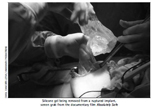![]() So, the silicone’s hit the fan.
So, the silicone’s hit the fan.
The use of industrial-grade silicone intended for mattresses, the possible fraud in hiding information from inspectors at production stage, and the failure in quality control in the regulatory phase, are particularly outrageous. However, the rapidly expanding private sector provision of breast implants for cosmetic reasons, by an “industry” that has been permitted to remain self-regulating in spite of evidence of its shortcomings and the risks involved, was a public health problem waiting to happen.
According to a 2010 review by Melanie Latham, [1] after the Labour government came to power in 1997, Labour MP Ann Clywd raised debates in the House of Commons about the possible risks of silicone from breast implants leaking into the patient’s body. Some efforts to regulate the private cosmetic surgery sector took place: in the Standards Care Act 2000, the Health and Social Care (Community Health and Standards) Act 2003, the National Health Service Act 2006, and the Health and Social Care Act 2008. These acts provided for a system of registration and inspection of private facilities and providers, but left the supervision of these regulations within a system of self-regulation, largely in the hands of private surgeons and clinics themselves. [1] Powers of entry and inspection of premises were handed over to the Care Quality Commission in 2008, a body that has experienced more criticism than one could reasonably expect it to survive. [2]
In the meantime, criticisms arose which have dogged the industry for over a decade: [1] that clinics were not adhering to minimum standards set in 2000, not monitoring quality of care and not recording adverse events. Accusations were levelled that they lacked written guidance on clinic procedures, published misleading advertisements about the potential success of treatments and had informal and undocumented complaints procedures and inadequate registration of surgeons.
Ann Clywd’s calls for an independent umbrella body to govern the cosmetic surgery profession, the most recent in 2008, [3] went unheeded. In 2009, the president of the British Association of Aesthetic Plastic Surgeons said: “In no other area of medicine is there such an unregulated mess. What is worse is that national governments would not allow it to happen in other areas of medicine. Imagine a ‘2-for-1’ advert for general surgery? That way lies madness!” [4]
Little did he know that Health Secretary Andrew Lansley, by opening the door to privatisation of health care on a wide scale, would make it even more likely that such problems might occur. The Health and Social Care bill is scheduled for report stage—where MPs discuss possible amendments—on 6 February. Lansley’s own response to the current implant fiasco has changed practically by the day and has included a mix of moral outrage on behalf of patients and threats to pursue, through the courts, the cosmetic industry companies that are refusing free removal of the sub-standard implants. [5] Why? Because, as he told the House of Commons, he didn’t think the NHS should foot the bill except for women whose implants were provided on the NHS (almost all of them women who have had breast cancer).
Some of the companies, for their part, are refusing to remove or replace the implants, or refusing to do it free of charge, for fear of bankruptcy. They hold the government responsible for failing to stop the implants coming into the country in the first place. The Medicines and Healthcare Products Regulatory Agency say there is no evidence of cancer risk and that women need not have the devices removed. [6] The bottom line is that in a fiasco, no one wants to take responsibility because of the cost, which reduces women’s health to a political football. Madness? No, these are the consequences of failure to control private medicine.
Is there a risk of cancer if you have mattress material in your tits for the next 5, 10, or 25 years? Who knows! Who wants to wait to find out the hard way? Women who fear the further risks of more surgery in order to have them removed, for a start. How are breasts repaired after they’ve had implants in place, particularly in women who have had breast cancer and may have tissue damage from surgery, radiotherapy, and chemotherapy? This is a serious dilemma, not the sort of “choice” Andrew Lansley goes on about.
Is there a greater risk of rupture with mattress material than with approved silicone gel? How can we know when private clinics are not obliged to keep such records and, even if they do, cite “commercial confidentiality” [7] to get out of reporting what data they may have? The so-called Independent Healthcare Advisory Service, which actually represents the major cosmetic surgery companies, claims to have audited all its members about the risk of rupture, and says data showed a rupture rate “within the industry standard of 1-2%.” Who set that “standard?” The industry, of course. Is it acceptable that implants have been found to rupture on average in one to two of every 100 women who have them? Let alone in the 7% reported in a small sample of 100 patients conducted by Transform, one of the biggest cosmetic surgery companies? [8] Acceptable—absolutely not!
But that’s not all. Breast implants cause a lot of problems that we rarely hear about. Last month, for example, the New England Journal of Medicine reported the case of a woman, who had had a mastectomy and later heart surgery, whose breast implant was dislodged during a Pilates breathing exercise. It migrated through the space between her ribs to sit next to a lung and had to be surgically removed and replaced. [9]
The National Research Center for Women and Families, a USA-based, non-profit research and information centre that provides information about breast implants to about 1,000 women annually, reports that all breast implants carry a risk of the following: tightening or hardening of the scar tissue around the implant (which can be painful and disfiguring); rupture of the shell holding the silicone; leaking of silicone following rupture (requiring an MRI to detect accurately and surgery to remove it); autoimmune symptoms in women whose implants have leaked; risks related to removal (this “explanting” is a rare skill even in the USA, the breast implant capital of the world); negative effects on breastfeeding; reduced accuracy of mammograms (serious especially for women who have had cancer); breaking of implants due to pressure during mammography; and the need for subsequent surgery for many of these problems. [10] And let’s not forget the absence of any requirement to provide adequate information to women considering implants in the first place.
Lastly, what does it cost? Breast enlargement at a Transform clinic, according to their website last week, costs £1000 deposit and £224.58 per month payable over one year (a total of £3694.96), or £250 deposit and £88 per month over five years (a total of £5580). This is before we begin to talk about the financial implications for women of having to pay for additional procedures to check for and repair the consequences of a rupture, leaking silicone etc, on top of the implant surgery itself. What caused this fiasco? In the UK, breast implants for purely cosmetic reasons are a highly profitable part of our burgeoning private medicine industry. Welcome to Andrew Lansley’s “new” NHS, American-style.
And now solicitors can get their share too!
http://www.medicalnewstoday.com/articles/239370.php
Accessed 13-1-12.
Silicone gel being removed from a ruptured implant
From: Reproductive Health Matters 2010;18(35):96
References
1. Latham M. A poor prognosis for autonomy: self-regulated cosmetic surgery in the UK. Reproductive Health Matters 2010;18(35):47-55.
2. Hawkes N. The Care Quality Commission: unfit for purpose? BMJ 2011;343:d8034.
3. Hansard 6 March 2008, column 1957. Reported in Latham [1].
4. Mercer N. Clinical Risk 2009;15:215-217. Quoted in [1].
5. Boseley S. Breast implant scandal: comestic surgery companies face court action. The Guardian. 11 January 2012.
6. Reported in: Keeley B MP. Breast implants: why a review is welcome [Letter]. The Guardian 3 January 2012.
7. Campbell D. Plastic surgeons facing “significant” rise in legal action. The Guardian. 9 January 2011.
8. Boseley S, Meikle J, Willsher K. Implant firms say rupture rate is within the norm. The Guardian 4 January 2012.
9. Fong TC, Hoffmann B. Disappearance of a breast prosthesis during pilates. N Engl J Med 2011;365:2305.
10. Zuckerman DM. Reasonably safe? Breast implants and informed consent [Commentary]. Reproductive Health Matters 2010;18(35):94-102.
11. At: http://www.transforminglives.co.uk/procedure-prices.html. Accessed 13-1-12.
Marge Berer, is the editor, Reproductive Health Matters


